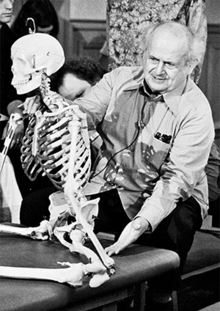I have taken 9 Feldenkrais' introductory 90 minute group classes from a local Feldenkrais practitioner, Christine Toscano. I also practice this method alone at home. I have also read a number of books on the subject.
Mrs. Toscano recommended we read Chapter 5 of the book by Norman Doidge, M.D., "The Brain's Way of Healing: Remarkable Discoveries and Recoveries from the Frontiers of Neuroplasticity," (Penguin Books, 2016). The chapter covers the life and work of Moshe Feldenkrais (1904-1984). He was a Ph.D. engineer, kudo master, movement therapist, author, and healer. The chapter discusses some of the core principles of his theory and methods as follows:
"1. The mind programs the functioning of the brain.
2. A brain cannot think without motor function.
3. Awareness of movement is the key to improving movement.
4. Differentiation: making the smallest possible sensory distinctions between movements - builds brain maps.
5. Differentiation is easiest to make when the stimulus is smallest.
6. Slowness of movement is the key to awareness, and awareness is the key to learning.
7. Reduce the effort whenever possible. Relax.
8. Errors are essential, and there is no right way to move, only better.
9. Random movements provide variation that leads to developmental breakthroughs.
10. Even the smallest movement in one part of the body involves the entire body.
11. Many movement problems, and the pain that goes with them, are caused by learned habit, not by abnormal structure."
Awareness Through Movement. Easy-To-Do Health Exercises to Improve Your Posture, Vision, Imagination and Personal Awareness. By Moshe Feldenkrais. HarperOne, Reprint edition, 2009. 192 pages. ISBN: 978-0062503220. VSCL.
Awareness Heals: The Feldenkrais Method for Dynamic Health. By Stephen Shafarman. Da Capo Lifelong Books, 1997. 224 pages. ISBN: 978-0201694697. VSCL.
The Brain's Way of Healing: Remarkable Discoveries and Recoveries from the Frontiers of Neuroplasticity. By Norman Doidge, M.D.. Penguin Books, 2016.
Change Your Age: Using Your Body and Brain to Feel Younger, Stronger, and More Fit. By Frank Wildman, Ph.D.. Da Capo Lifelong Books, 2010. 240 pages. ISBN: 978-0738213637. VSCL.
Embodied Wisdom: The Collected Papers of Moshe Feldenkrais. Edited by Elizabeth Beringer. Foreword by David Zemach-Bersin. North Atlantic Books, 1st Edition, 2010. 256 pages. ISBN: 978-1556439063. VSCL.























